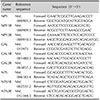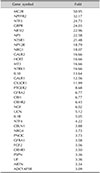1. Becker SW. Concurrent melanosis and hypertrichosis in distribution of nevus unius lateris. Arch Derm Syphilol. 1949; 60:155–160.


2. Glinick SE, Alper JC, Bogaars H, Brown JA. Becker's melanosis: associated abnormalities. J Am Acad Dermatol. 1983; 9:509–514.


3. Person JR, Longcope C. Becker's nevus: an androgen-mediated hyperplasia with increased androgen receptors. J Am Acad Dermatol. 1984; 10:235–238.


4. Stanford DG, Georgouras KE. Dermal melanocytosis: a clinical spectrum. Australas J Dermatol. 1996; 37:19–25.


5. Zvulunov A, Esterly NB. Neurocutaneous syndromes associated with pigmentary skin lesions. J Am Acad Dermatol. 1995; 32:915–935.


7. Bousema MT, Vuzevski V, Oranje A, Heule F, Stolz E, van Joost T. Non-von Recklinghausen's neurofibromatosis resembling a giant pigmented nevus. J Am Acad Dermatol. 1989; 20:358–362.


8. Zvulunov A, Metzker A. Neurofibromatosis versus giant pigmented nevus. J Am Acad Dermatol. 1990; 23:956–957.


9. Bak H, Lee HJ, Chang SE, Choi JH, Kim MN, Kim BJ. Increased expression of nerve growth factor receptor and neural endopeptidase in the lesional skin of melasma. Dermatol Surg. 2009; 35:1244–1250.


10. Pahwa P, Sethuraman G. Segmental Becker's nevi with mucosal involvement. Pediatr Dermatol. 2012; 29:670–671.


11. Ro YS, Ko JY. Linear congenital Becker nevus. Cutis. 2005; 75:122–124.

13. Gilaberte Y, Roca MJ, Garcia-Prats MD, Coscojuela C, Arbues MD, Vera-Alvarez JJ. Neuropeptide Y expression in cutaneous melanoma. J Am Acad Dermatol. 2012; 66:e201–e208.

14. Gilaberte Y, Vera J, Coscojuela C, Roca MJ, Parrado C, González S. [Expression of galanin in melanocytic tumors]. Actas Dermosifiliogr. 2007; 98:24–34. Spanish.


15. Tomita Y, Maeda K, Tagami H. Mechanisms for hyperpigmentation in postinflammatory pigmentation, urticaria pigmentosa and sunburn. Dermatologica. 1989; 179:Suppl 1. 49–53.


16. Nelson JS, Applebaum J. Treatment of superficial cutaneous pigmented lesions by melanin-specific selective photothermolysis using the Q-switched ruby laser. Ann Plast Surg. 1992; 29:231–237.


17. Goldberg DJ. Benign pigmented lesions of the skin. Treatment with the Q-switched ruby laser. J Dermatol Surg Oncol. 1993; 19:376–379.

18. Chapel TA, Tavafoghi V, Mehregan AH, Gagliardi C. Becker's melanosis: an organoid hamartoma. Cutis. 1981; 27:405–406. 410415

19. Metin A, Tuncay I, Uğraş S. About the paper "Elephantiasis neuromatosa and Becker's melanosis" (J Dermatol, 26: 396-398, 1999). J Dermatol. 2001; 28:112–113.


20. Hara M, Kumasaka K, Tomita Y, Tagami H. Unilateral dermatomal pigmentary dermatosis: a variant dyschromatosis? J Am Acad Dermatol. 1992; 27:763–764.


21. Bröcker EB, Magiera H, Herlyn M. Nerve growth and expression of receptors for nerve growth factor in tumors of melanocyte origin. J Invest Dermatol. 1991; 96:662–665.


22. Lazarova R, Hristakieva E, Lazarov N, Shani J. Vitiligo-related neuropeptides in nerve fibers of the skin. Arch Physiol Biochem. 2000; 108:262–267.


23. Kim SY, Kim MY, Kang H, Kim HO, Park YM. Becker's naevus in a patient with neurofibromatosis. J Eur Acad Dermatol Venereol. 2008; 22:394–395.


24. Mahé E, Zeller J, Wechsler J, Wolkenstein P, Revuz J. [Large hairy pigmented spots in neurofibromatosis type 1: an atypical form of neurofibromas]. Ann Dermatol Venereol. 2001; 128:619–621. French.

25. Tatemoto K. Neuropeptide Y and its receptor antagonists. Use of an analog mixture-screening strategy. Ann N Y Acad Sci. 1990; 611:1–6.
26. Pedrazzini T, Pralong F, Grouzmann E. Neuropeptide Y: the universal soldier. Cell Mol Life Sci. 2003; 60:350–377.

27. Scheenen WJ, Jenks BG, Willems PH, Roubos EW. Action of stimulatory and inhibitory alpha-MSH secretagogues on spontaneous calcium oscillations in melanotrope cells of Xenopus laevis. Pflugers Arch. 1994; 427:244–251.


28. Weihe E, Hartschuh W. Multiple peptides in cutaneous nerves: regulators under physiological conditions and a pathogenetic role in skin disease. Semin Dermatol. 1988; 7:284–300.

29. Takahashi K, Nakanishi S, Imamura S. Direct effects of cutaneous neuropeptides on adenylyl cyclase activity and proliferation in a keratinocyte cell line: stimulation of cyclic AMP formation by CGRP and VIP/PHM, and inhibition by NPY through G protein-coupled receptors. J Invest Dermatol. 1993; 101:646–651.


30. Berger A, Santic R, Hauser-Kronberger C, Schilling FH, Kogner P, Ratschek M, et al. Galanin and galanin receptors in human cancers. Neuropeptides. 2005; 39:353–359.


31. Grenbäck E, Bjellerup P, Wallerman E, Lundblad L, Anggård A, Ericson K, et al. Galanin in pituitary adenomas. Regul Pept. 2004; 117:127–139.


32. Kofler B, Berger A, Santic R, Moritz K, Almer D, Tuechler C, et al. Expression of neuropeptide galanin and galanin receptors in human skin. J Invest Dermatol. 2004; 122:1050–1053.


33. Hafner C, Stempfl T, Bäumler W, Hohenleutner U, Landthaler M, Vogt T. Gene expression profiling of melanocytes following Q-Switched Ruby laser irradiation. Dermatology. 2008; 216:6–13.


34. Dallos A, Kiss M, Polyánka H, Dobozy A, Kemény L, Husz S. Galanin receptor expression in cultured human keratinocytes and in normal human skin. J Peripher Nerv Syst. 2006; 11:156–164.


35. Ji RR, Zhang X, Zhang Q, Dagerlind A, Nilsson S, Wiesenfeld-Hallin Z, et al. Central and peripheral expression of galanin in response to inflammation. Neuroscience. 1995; 68:563–576.


36. Carraway R, Leeman SE. The isolation of a new hypotensive peptide, neurotensin, from bovine hypothalami. J Biol Chem. 1973; 248:6854–6861.


37. Dupouy S, Mourra N, Doan VK, Gompel A, Alifano M, Forgez P. The potential use of the neurotensin high affinity receptor 1 as a biomarker for cancer progression and as a component of personalized medicine in selective cancers. Biochimie. 2011; 93:1369–1378.


38. Theoharides TC, Stewart JM, Taracanova A, Conti P, Zouboulis CC. Neuroendocrinology of the skin. Rev Endocr Metab Disord. 2016; 17:287–294.


39. Alysandratos KD, Asadi S, Angelidou A, Zhang B, Sismanopoulos N, Yang H, et al. Neurotensin and CRH interactions augment human mast cell activation. PLoS One. 2012; 7:e48934.

40. Muallem MM, Rubeiz NG. Physiological and biological skin changes in pregnancy. Clin Dermatol. 2006; 24:80–83.


41. Peters EM, Ericson ME, Hosoi J, Seiffert K, Hordinsky MK, Ansel JC, et al. Neuropeptide control mechanisms in cutaneous biology: physiological and clinical significance. J Invest Dermatol. 2006; 126:1937–1947.

42. Nordlund JJ. Postinflammatory hyperpigmentation. Dermatol Clin. 1988; 6:185–192.


43. Maimone D, Cioni C, Rosa S, Macchia G, Aloisi F, Annunziata P. Norepinephrine and vasoactive intestinal peptide induce IL-6 secretion by astrocytes: synergism with IL-1 beta and TNF alpha. J Neuroimmunol. 1993; 47:73–81.


44. Gottschall PE, Tatsuno I, Arimura A. Regulation of interleukin-6 (IL-6) secretion in primary cultured rat astrocytes: synergism of interleukin-1 (IL-1) and pituitary adenylate cyclase activating polypeptide (PACAP). Brain Res. 1994; 637:197–203.











 PDF
PDF ePub
ePub Citation
Citation Print
Print






 XML Download
XML Download